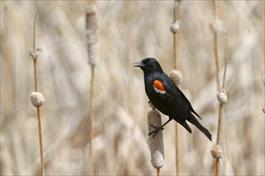A comprehensive survey of Tricolored Blackbirds Agelaius tricolor in California has confirmed that the population of the species has declined nearly 35 percent in the last three years. The 2011 survey, conducted by Audubon California with the help of more than 100 volunteers, estimated the population to be about 259,000 birds, down from approximately 395,000 in 2008. Historic populations once numbered in the millions.
The survey across 29 counties confirmed that the Tricolored Blackbird still resides almost entirely in California’s San Joaquin Valley, with a full 89 percent of the surveyed birds found there. The survey also confirmed that the bird continues to struggle in southern California. Once the most common bird in San Diego County, only about 5,000 individuals now remain in this part of the state. The Tricolored Blackbird forms the largest colonies of any North American land bird, often breeding in groups of tens of thousands of individuals. Loss of a single colony, therefore, can have a significant impact on the total population. Tricolors also suffer generally low reproductive success at several major colonies.
FOOD HABITS
FORAGING STRATEGY
Central place foraging from colonies, typically within a kilometer or two of colonies but not infrequently to six or more km.
DIET
Tricolors opportunistically respond to insect abundance, thriving on grasshopper and other insect outbreaks.
Spring pre-breeding foraging: Grains associated with dairy feedlots, cracked corn, sprouting rice, ripening oats, milk barley.
Breeding season foraging: Grasshoppers; opportunistic foragers of any abundant insect resource including grasshoppers, beetles, weevils, caddis fly larvae, moth and butterfly larvae, dragonfly larvae, lakeshore midges. Animal matter comprises 91% of the food volume of nestlings and fledglings, 28% adult males, and 56% adult females.
Post breeding and fall foraging: Agricultural cropland with alfalfa and rice, irrigated pasture, lightly grazed grasslands, livestock operations and dairy feedlots.
Winter foraging: Seeds from pasture grassland and weeds, animal matter as available.
Sources:
SURFBIRDS NEWS, August 5, 2011
http://www.surfbirds.com/sbirdsnews/archives/2011/08/survey_reveals_1.h…
California Partners In Flight Riparian Bird Conservation Plan
http://www.prbo.org/calpif/htmldocs/species/riparian/tricolored_blackbi…

- Login om te reageren
